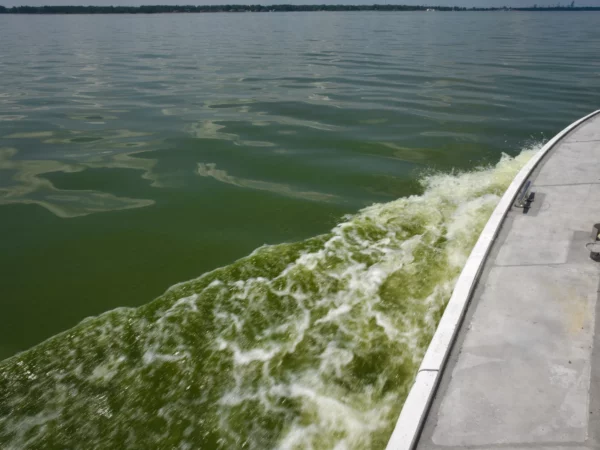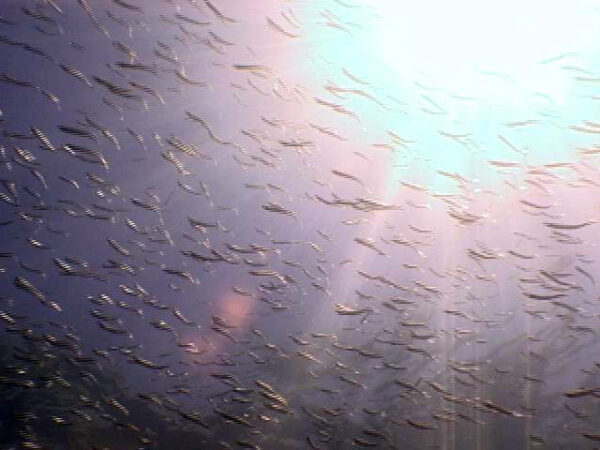
By Rebecca Williams, Michigan Radio
The Great Lakes News Collaborative includes Bridge Michigan; Circle of Blue; Great Lakes Now at Detroit Public Television; and Michigan Radio, Michigan’s NPR News Leader; who work together to bring audiences news and information about the impact of climate change, pollution, and aging infrastructure on the Great Lakes and drinking water. This independent journalism is supported by the Charles Stewart Mott Foundation. Find all the work HERE.
One of the worst oil spills into an inland waterway in U.S. history happened right here in Michigan, 10 years ago in July.
It happened on a Sunday evening: 5:58 p.m. on July 25, 2010.
Enbridge’s Line 6B was carrying diluted bitumen. It’s a dark, thick oil from Canada’s tar sands. The pipeline split open in a wetland near the small town of Marshall.
Oil gushed into Talmadge Creek, then the Kalamazoo River, polluting almost 40 river miles. Enbridge estimated more than 840,000 gallons of oil spilled. The EPA put the amount at more than one million gallons.
People who lived near the spill site, like Debbie Trescott, said there was an intense smell hanging in the air that Sunday.
“I smelled this oil or gas or something. It was just a horrible smell and I knew then that something must be wrong,” Trescott said.
But Enbridge did not realize anything was wrong for more than 17 hours.
The control room operators were far away, in Alberta.
A federal investigation later found those operators thought they had a pressure problem, and an issue called column separation, in the pipeline. They shut the pipeline down twice. And twice, they restarted it, sending massive amounts of oil through the ruptured pipeline.
81% of the oil that spilled was a result of those mistakes, according to the National Transportation Safety Board’s investigation.
Catch up on more about the Kalamazoo River oil spill on Great Lakes Now:
Turtle Recovery: Studying turtles on the Kalamazoo River 10 years after Enbridge oil spill
Turtles vs. Oil: Great Lakes Now producer talks ecosystems, life on the water and covering the lakes
API key not valid. Please pass a valid API key.Related Michigan Radio stories:
Looking back at Michigan Radio’s coverage of the Kalamazoo River oil spill
Study points to mixed results for turtles 10 years after oil spill
TIMELINE: 15 moments to note since the biggest inland oil spill in U.S. history
People who lived nearby or spent time on the Kalamazoo River said the river ran black.
“The water going over the rocks didn’t sound like water going over the rocks. It almost sounded like a kid sucking on a super thick milkshake,” outdoorsman Craig Ritter told us.
“I think I can sum it up in one word and that is nightmare,” resident Deb Miller recalled. “The smell, I don’t even know how to describe the smell, there are no words. You could not be outside.”
Miller told us in 2011 she had health problems that lasted for months after the spill.
“The headaches were just absolutely intense, watering eyes. The cough, it was chronic,” Miller said.
In late 2010, the state health department issued a report on acute health effects from the oil spill. The report said people in the area had headaches, nausea, and respiratory symptoms.
In the early days, there was a major wildlife rescue effort. Turtles, muskrats, and great blue herons were covered in oil. Rescue teams collected more than 2,000 birds and animals.
Back then, herpetologist Dave Mifsud said turtles made up the most of the wildlife rescued from the spill site.
“We had some, that were, their mouths were so tacky with the oil they could barely open their mouths. We saw some pretty devastating things,” Mifsud said.
The state is still monitoring the health of aquatic life in the area, among other restoration work. The river re-opened for recreation in 2012. But it took many years to clean up and restore the river.
The main reason? The kind of oil that was spilled.
Because it was so heavy and thick, a lot of it sank to the bottom of the river. Federal and state officials said that made the cleanup more difficult.
Two years after the spill, crews were still searching for oil on the bottom of the Kalamazoo River.
In 2012, Mark Ducharme with the state’s environment agency told us they were struggling to learn how to clean up this kind of oil.
“We’re writing the book on how to clean up oil sands out of cold water streams in freshwater systems. We’ve been looking elsewhere, we’ve been trying to find other examples – they’re just not there,” Ducharme said.
Enbridge replaced Line 6B across the state of Michigan starting in 2012. But the company replaced it with a larger pipeline, and to do that, Enbridge asked for an additional amount of easement from homeowners.
Many people signed contracts with the company. But Enbridge took people who refused to sign contracts to court.
What went wrong
An investigation by the National Transportation Safety Board said the pipeline ruptured because of corrosion and cracking. It found that Enbridge was aware of six crack-like defects in Line 6B five years before the pipeline broke open, but did nothing to fix them. Investigators said there were “pervasive organizational failures” by Enbridge.
The NTSB also blamed weak regulations and “ineffective oversight” by the Pipeline and Hazardous Materials Safety Administration, the federal agency that oversees pipelines.
In a statement, Enbridge spokesman Ryan Duffy says the company transformed itself as a result of the spill:
The Kalamazoo River where the incident occurred is clean and has been open to the public since 2012.
The result of the spill in Marshall is a company with increased awareness of safety and focused attention on proactive measures to maintain safe operation. Enbridge transformed itself to prevent a similar incident from happening in the future.
Since 2011, Enbridge has invested more than $8 billion on maintenance, inspection and leak detection across our crude-oil pipeline system. This is the largest, most comprehensive and sophisticated maintenance and inspection program of any pipeline system in the world.
We’ve increased the number of inline inspections conducted on the liquids pipeline mainline system using high-tech tools that are similar to mini-MRI machines.
Enbridge has added staff to the Control Center, while also revising and enhancing all control center procedures related to decision making, pipeline startup and shutdown, leak detection system alarms and communication protocols. We have also increased staffing for the emergency response and safety teams for our liquids pipelines system.
Enbridge has significantly increased its readiness to respond to any incident by conducting hundreds of emergency response drills annually to be sure the right equipment and trained professionals are in place and prepared to respond.
In the last several years, we have conducted thousands of exercises, drills and deployment events across the company.
Carl Weimer heads the watchdog group Pipeline Safety Trust. He agrees: some things have improved since the Kalamazoo spill.
“If they hadn’t spilled a million gallons, I’m not sure there’d be this much attention to all the other lines in the Midwest right now,” he said.
Weimer said there have been several changes in the industry, including how control room operators are trained. And there are new federal regulations on pipelines that are just now going into effect this month, 10 years later.
“But there are good things in those rules, about how do you deal with oil spills, integrating risks so you don’t look at corrosion and cracking separately; you have to integrate those risks, that’s been changed,” he said.
But he said there’s one major thing that has not changed in the past decade.
Pipeline companies still do their own inspections.
“The regulators, when they say they inspect pipelines, they’re inspecting the paperwork, they’re not going out there and inspecting the pipeline, for the most part,” said Weimer. “So you have to trust the companies and you have to trust that the regulators are at least spending enough time on the paperwork and overseeing the company that there’s some hope there.”
He said PHMSA, the federal agency that oversees pipelines, doesn’t put its inspection reports online.
“You can get them if you go through the FOIA (Freedom of Information Act) process, but sometimes that’s a godawful thing to try to do,” he said.
But Weimer said states can ask the federal government for permission to do additional inspections on oil pipelines that cross state lines.
“One of the things I’m surprised about that didn’t come out of Michigan is that the state still hasn’t stepped up and taken any regulatory authority over these types of pipelines. I’m surprised the state of Michigan hasn’t done that,” he said.
A spokesman for the Michigan Public Service Commission, Matt Helms, says it’s true – states can ask to take on more inspection responsibility over pipelines that cross state lines. But Helms said that first, the Legislature would have to make some changes to give his agency or others the authority to adopt federal pipeline rules:
Yes, states do have the ability to request additional pipeline inspection responsibilities from the federal government for interstate hazardous liquids pipelines. Under current Michigan law, the MPSC does not regulate the safety of interstate hazardous liquids pipelines. Public Act 16 of 1929 does provide the MPSC with siting authority of hazardous liquid pipelines. The MPSC’s safety authority is limited to gas pipelines. For the state of Michigan to seek additional inspection authority of interstate hazardous liquids pipelines, the Legislature would have to enact new laws or amend existing laws to include hazardous liquids pipelines and give the MPSC (or appropriate state agency) the authority to adopt federal pipeline rules before the state could seek additional inspection responsibilities from the Secretary of Transportation/PHMSA.
The Pipeline Safety Trust’s Carl Weimer noted the spill woke a lot of people up to the existence of the pipelines that crisscross our region.
“I think a lot of the attention you’re seeing on Enbridge lines in Wisconsin, Minnesota, the Upper Peninsula of Michigan, some of the tribal issues in northern Wisconsin, certainly Line 5 now, has all been heightened because of Enbridge’s spill,” said Weimer.
He said there is a lot more attention now to how pipeline companies assess their risks. But he said it’s unfortunate that in the U.S. we often don’t change laws or the way we do things until after a tragedy happens.
Editor’s note: Enbridge is one of Michigan Radio’s corporate sponsors.
This story has been corrected to reflect that it’s unclear whether the Line 6B spill near Marshall, Mich. is the largest oil spill into an inland waterway in U.S. history. A 1991 spill in Grand Rapids, Minnesota sent approximately 1.3 million gallons of oil into a field, but some of the oil – it’s unclear how much – migrated down a storm drain that emptied into the Prairie River.
Featured image: Great blue heron covered in oil from the 2010 Enbridge oil spill near Marshall, Michigan. (Credit State of Michigan via Michigan Radio)




